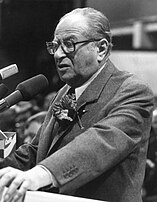
Back قائمة مستشاري النمسا Arabic Llista de cancilleres d'Austria AST Федерален канцлер (Австрия) Bulgarian Seznam kancléřů Rakouska Czech Liste der Bundeskanzler der Republik Österreich German Κατάλογος καγκελαρίων της Αυστρίας Greek Anexo:Canciller de Austria Spanish فهرست صدراعظمهای اتریش Persian Luettelo Itävallan liittokanslereista Finnish Liste des chanceliers fédéraux d'Autriche French
- Renner was the first chancellor of German-Austria, the First Republic, and the Second Republic.
- Dollfuss turned the First Republic into a dictatorship.
- For most of his incumbency, Kurz was the world's youngest head of government.
- Kreisky is considered perhaps Austria's most successful Socialist leader.[1]
The chancellor of Austria is the head of government of Austria, appointed by the president and viewed as the country's de facto chief executive. The chancellor chairs and leads the Cabinet, which also includes the vice-chancellor and the ministers.[2]
Following World War I, the office was established by the Provisional National Assembly on 30 October 1918 and named state chancellor of the Republic of German-Austria, and its first holder, Karl Renner, was appointed by the State Council. After the Allied powers denied German-Austria to merge with the Weimar Republic,[3] the country formed the federal First Austrian Republic and the office was renamed from state chancellor to federal chancellor. The first federal chancellor was Michael Mayr. There have been ten chancellors who served under the First Republic until Chancellor Engelbert Dollfuss created the authoritarian and dictatorial Federal State of Austria.[4] Following Dollfuss's assassination by Austrian National Socialists,[5] Kurt Schuschnigg succeeded him as chancellor and upheld the dictatorship.[6] Schuschnigg was replaced by Arthur Seyss-Inquart, a Nazi caretaker who held the office for two days, until Austria was annexed into Nazi Germany.[7]
Austria under National Socialism lost its original republican system of government and was administered by Reichsstatthalter Arthur Seyss-Inquart (1938–1939), Reichskommissar Josef Bürckel[8] (1939–1940) and Reichsstatthalter Baldur von Schirach[9] (1940–1945). In 1940, the country was renamed Ostmark, completely lost its autonomy, and became a sub-national division of Nazi Germany.[10][11] After the liberation of Vienna and the capitulation of Nazi Germany in 1945, Austria restored its republican form of government.[12] However, Austria remained under allied occupation until 1955[13] and thus the country's sovereignty was ultimately still held by the Allied Control Council.
Since the institution of the republic, the People's Party and the Social Democratic Party have largely dominated Austrian politics; the People's Party (and its predecessor, the Christian Social Party) have led nineteen cabinets and served as a junior partner in eight, while the Social Democratic Party (formerly the Social Democratic Workers' Party) has led eleven and served as a junior partner in five. There have been seven parties that never held the chancellorship but participated in coalition cabinets: the Greater German People's Party in five, the Freedom Party and the Landbund in four, the Fatherland Front in two, and the Greens, the Alliance for the Future and the Communist Party in one.
Following a legislative election or in the case of a vacancy, the president conventionally picks the leader of the largest party in Parliament to serve as chancellor, and appoints the remaining members of the Cabinet based on the chancellor's recommendation. If a sitting chancellor dies, resigns, or is otherwise unable to exercise the powers and duties of the office, the vice-chancellor becomes acting chancellor. If the vice-chancellor is unavailable, the other members of the Cabinet take over in order of seniority.[14]
Bruno Kreisky was the longest-serving chancellor, with more than thirteen years in office, while Arthur Seyss-Inquart was the shortest-serving chancellor, with two days in office, and Walter Breisky was the shortest-serving acting chancellor, with only one day in office.
- ^ "Power limited for Austrian foreign minister, fan of Bruno Kreisky, critic of Juncker". euractiv.com. 19 December 2017. Retrieved 30 October 2021.
- ^ "Bundeskanzler Sebastian Kurz". bundeskanzleramt.gv.at (in German). Archived from the original on 22 December 2017. Retrieved 3 March 2019.
- ^ "Treaty of Saint-Germain". Britannica. Retrieved 11 March 2019.
- ^ "First Republic and the Anschluss". Britannica. Retrieved 8 March 2019.
- ^ "The assassination of Engelbert Dollfuss, July 25, 1934". eclecticatbest.com. Retrieved 8 March 2019.
- ^ "Kurt von Schuschnigg". Britannica. Retrieved 8 March 2019.
- ^ "Arthur Seyss-Inquart". Britannica. Retrieved 8 March 2019.
- ^ "Josef Bürckel". geschichtewiki.wien.gv.at (in German). Retrieved 8 March 2019.
- ^ "Baldur von Schirach". geschichtewiki.wien.gv.at (in German). Retrieved 8 March 2019.
- ^ "Gesetz über Gebietsveränderungen in Österreich". alex.onb.ac.a (in German). Retrieved 8 March 2019.
- ^ "Anschluss". Britannica. Retrieved 8 March 2019.
- ^ "The years of the Allied Forces in Vienna". wien.gv.at. Retrieved 8 March 2019.
- ^ "Full text of the Austrian State Treaty" (PDF). treaties.un.org. Retrieved 8 March 2019.
- ^ "Art. 69 B-VG". jusline.at (in German). Retrieved 4 March 2019.
© MMXXIII Rich X Search. We shall prevail. All rights reserved. Rich X Search



